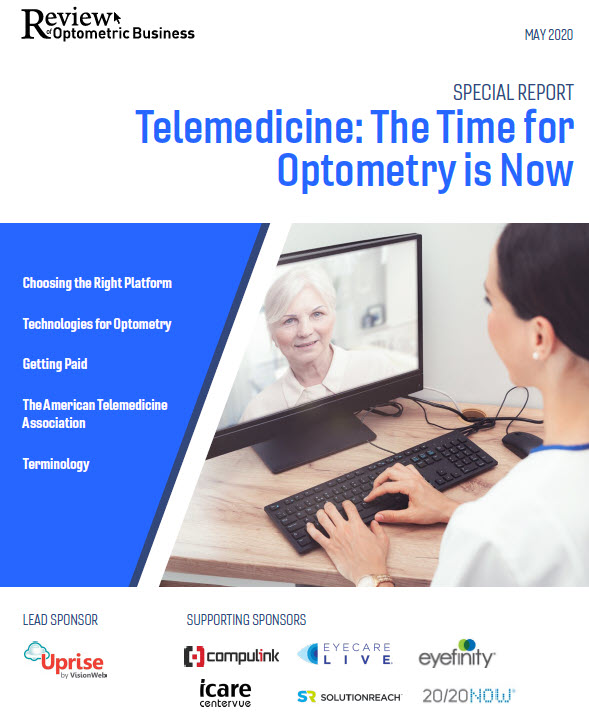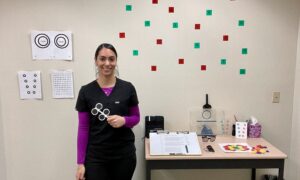
Click HERE or the image above to download “Telemedicine: The Time for Optometry is Now”
By Mike Rothschild, OD
July 1, 2020
The professional editor of “Telemedicine: The Time for Optometry is Now” answers eyecare professionals’ questions about using telemedicine for optometry.
Although the coronavirus pandemic required many eyecare professionals to quickly learn and implement telemedicine, many questions remain about how to best incorporate it as a routine part of your practice and how to generate revenue by doing so.
Here are answers to some of those frequently asked questions regarding billing, diagnosis, treatment and regulations related to using telemedicine to practice optometry.
BILLING
How has billing and payment been so far?
Medical plans are paying, in general. While every medical plan is different, most have agreed to follow the same process as CMS and pay at the same level as in-office visits. But getting their systems to be able to handle the new modifiers has been a bit of a struggle. Pay attention to the EOBs.
Is telemedicine acceptable to third-party vision care plans?
The National Association of Vision Care Plans is working on a position paper related to this subject. There is not a different code for in-office exams with a distance provider. The place of service is the office and all of the required testing is done. We do not know of any official policy from any vision care provider at this point.
How do you charge the patient if they need to come into the office?
If a remote doctor refers to an in-person doctor at the same location, the patient would most likely be billed for both visits. It would be like a doctor asking a patient to return to the practice when a specialist is in the office a week later. As always, it depends on many variables, so be sure to follow the rules. If the patient is sent to your office on another day, you would bill twice, but not if on the same day.
Download Special Report
DIAGNOSIS & TREATMENT
How do you measure visual acuity?
There are several apps that measure visual acuity to varying degrees of accuracy. “Functional VA” is most often used during Virtual At-Home Visits (VAHoVs).
Other Pieces to Explore
How do you do a virtual refraction?
Subjective refractions are being provided successfully by a couple of vendors. These are done in a practice with a digital phoropter operated by a distance provider. Technology to refract in the patient’s home does not provide an adequate prescription of eyewear.
You mentioned you have adapted your virtual consultations to deliver a comprehensive eye exam or tenets of a comprehensive eye exam. How have you done this? How are glaucoma eye exams performed via telemedicine? How is the fundus/optic nerve seen? Is there a way to do OCT/VF virtually?
A VAHoV is a Virtual, At-Home Visit and is limited to testing and imagery that can be captured from the patient’s home. Comprehensive exams with a distance provider requires the patient to present to an office with the equipment that can upload these images and data to be evaluated by the doctor. Once the doctor and patient connect via an audiovisual connection, there is a synchronous telemedicine visit. Synchronous telehealth refers to the delivery of health information in real-time with the provider and the patient being connected by live audio and visual connection.
Are the corneal images that the patient takes using the apps clear enough to see things such as corneal ulcer?
Sometimes corneal images are clear enough to see corneal ulcer. It depends on many things – lighting, connection, type of camera being used. Rule #1 says that the doctor has to make a clinical judgement to determine if available information is enough to allow a sound clinical decision.
Explore New e-resource
How do your older patients react to telemedicine?
Older patients love it. They are typically more tech-savvy than you think and often have trouble getting to doctor visits. It is certainly not a good replacement for in-person care, but it can be a good supplement, especially for dry eye follow-ups. Plus, you can get a lot of information by seeing the patient’s environment when evaluating for dry eye irritants. All age groups find this method of care delivery acceptable and high quality.
How are you using telemedicine for low vision?
It is true that only certain parts lend itself to telemedicine, but sometimes, it is better. For low vision, the patient is often in their real world environment, where you can evaluate lighting needs and see how the patient lives.
REGULATIONS, ETC.
How do you handle state board rules when crossing state lines with services?
The telemedicine regulation is that the doctor must be licensed where the patient is located at the time of the interaction.
Is the telemedicine consultation recorded?
You would not want to record your session with a patient. This would be a HIPAA no-no.
Do we have to adjust our liability insurance for telemedicine?
Confirm with your current liability plan that you are covered for telemedicine.
Do you see new patients, or do you only accept existing patients?
You can see new or established patients with virtual visits.
>>Click HERE to download “Telemedicine: The Time for Optometry is Now”>>
 Mike Rothschild, OD, is the founder of West Georgia Eye Care in Carrollton, Ga, and the founder of Leadership OD. To contact him: mrothschild@LeadershipOD.com
Mike Rothschild, OD, is the founder of West Georgia Eye Care in Carrollton, Ga, and the founder of Leadership OD. To contact him: mrothschild@LeadershipOD.com



























